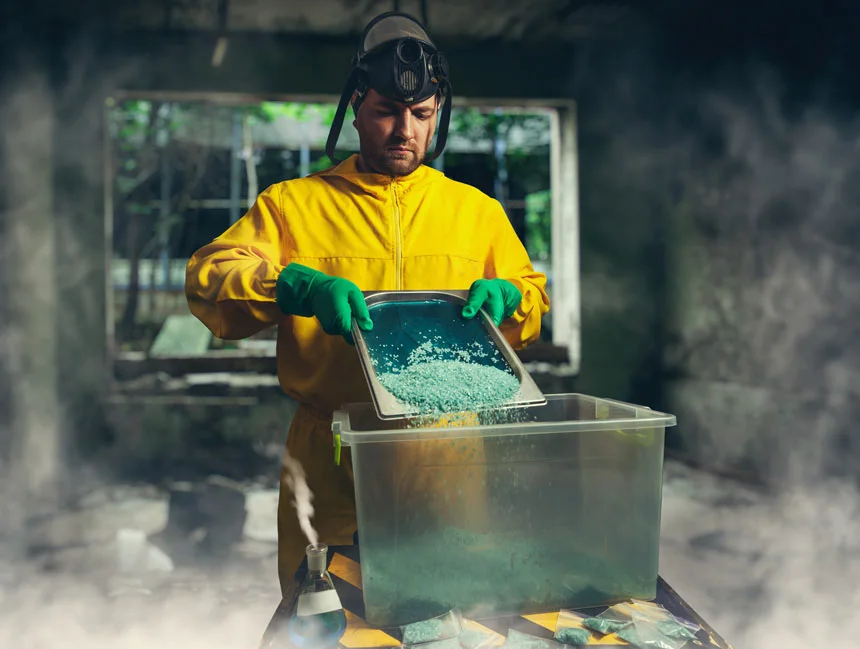What is Methamphetamine?
Table of Contents
- What is Methamphetamine?
- The History of Meth and Amphetamines in the U.S.
- What is P2P Meth?
- What are the Side Effects of P2P Meth?
- The Dangers of Replacing Ephedrine Meth
- The Relationship Between Meth and Mental Illness
- Meth Addiction Treatment Methods
- Find Meth Addiction Treatment That Works!
- P2P Meth: New Meth Is Stronger Than Ever (FAQ)
Currently classified as a Schedule II drug, methamphetamine is an extremely addictive and powerful central nervous system stimulant that is becoming increasingly dominant within the drug market. P2P meth represents a form of production that creates an even stronger, more dangerous version of the drug.
While most commonly found in the form of a white crystalline powder, meth may also be found in larger chunks that resemble quartz. It is this second form that earned it the popular nickname “crystal meth.”
Some amphetamines may be available medically, such as for managing symptoms of Attention Deficit Hyperactivity Disorder (ADHD), to aid with narcolepsy, or in weight-loss treatments. However, due to their high risk for abuse, this usage is usually very limited and only available with a prescription.
Keep reading to find out more about P2P meth, and how to get effective treatment for even this potent form of the drug!
The History of Meth and Amphetamines in the U.S.

Methamphetamine was first developed in the early 20th century, and was primarily used to help with congestion in the nasal and bronchial areas. However, by World War II, chemists had developed a synthesized version of this drug that could reach the brain faster.
This modified form began to be distributed amongst soldiers as a means of boosting their energy levels and motivation to fight. As time progressed, the stimulant effects of meth became more widely recognized.
This recognition, of course, resulted in a gradual increase in cases of meth use and addiction across the U.S.. Numbers, of which, continue to grow at alarming rates to this day, particularly within the past decade.
The Comprehensive Drug Abuse Prevention and Control Act of 1970 was passed in an attempt to limit access to and the use of amphetamines.
Unfortunately, this ended up only creating a larger market for the illegal manufacturing of these stimulants. Meth is predominantly produced and distributed by Mexican drug trafficking organizations.
However, meth production also occurs on a smaller scale domestically. One group that is notorious for the manufacturing and disbursement of illicit drugs, particularly meth, is the Hell’s Angels Motorcycle Club.
Members of this group and several other biker gangs also play a significant role in the trafficking of illegal substances and stolen goods in and out of the U.S..
What is P2P Meth?
While having recently taken a backseat to the opioid epidemic currently ravaging the U.S., this substance has been brought back to the forefront of public concern due to the emergence of a new meth variant.
Traditionally, meth manufacturing typically takes place in make-shift, typically home-based, laboratories. This is usually done through the use of cold medicines containing ephedrine.
However, recent restrictions placed on the availability of these medicines have caused a need for meth manufacturers to find new ways of producing this drug. Methods, of which, include higher concentrations of d-methamphetamine, as well as various other chemicals.
While both street and medical-grade meth will use both d-methamphetamine and l-methamphetamine, methamphetamine produced illegally will have less l-meth, as this isomer does not produce as intense of a high.
Some of the chemicals being used to create this new meth include:
- Acetone
- Cyanide
- Lye
- Mercury
- Sulfuric acid
- Hydrochloric acid
- Nitrostyerence
- Racing fuel
What are the Side Effects of P2P Meth?
Ephedrine-based meth will typically result in a high that can make its users extremely social and wakeful. Compared to old meth, P2P meth creates a much more intense high that may produce a number of side effects, including:
- Severe mental illness
- Psychosis
- Violent paranoia
- Isolating behavior
- Hallucinations
- Delusions
- Jumbled speech
- Massive memory loss
Individuals who abuse P2P meth may also experience particularly severe physical health consequences, such as liver failure or brain damage. This can occur even with short-term use of this drug.
Furthermore, any form of meth abuse can cause an increase in an individual’s blood pressure, heart rate, and respiratory rate.
The Dangers of Replacing Ephedrine Meth
Unfortunately, street manufacturers’ only goal in making this drug is to reap a profit. The well-being of their consumers is rarely ever a concern, as this new and extremely dangerous form of meth reminds the public.
Most producers create methamphetamine in unhygienic and unprofessional environments, which means meth users will often consume an extremely dangerous form of this drug.
This is particularly true for P2P meth, as it often contains toxic chemicals. Furthermore, this new meth will often be mixed with other dangerous drugs, including fentanyl.
According to the National Institute on Drug Abuse (NIDA) the number of meth overdoses has risen steeply in the past few years. Many of these overdose deaths, unfortunately, involved simultaneous opioid use.
In many cases, both meth and opioid users end up in intensive recovery programs when treating their drug use.
The Rise of Super Meth
Another new meth variant that has recently contributed to the re-emergence of the meth epidemic in the U.S. is “super meth.”
This form is believed to be at least 93% pure and is a particularly popular party drug due to its cheap cost and intense side effects. Some drug users who have taken super meth have reported experiencing highs that have lasted for up to 24 hours.
However, because of its purity, it is also far more addictive, and far more deadly than regular ephedrine meth, even though it usually looks very similar.
Particularly when combining too much meth with other drugs, such as fentanyl, an individual’s risk of experiencing adverse effects and potential overdose drastically increases.
Counterfeit Adderall: A Dangerous New Trend
As new versions of meth are being rapidly introduced into the drug market, so too are numerous variants of other drugs. This includes opioids and stimulants, two drugs that are also commonly abused by meth addicts.
However, this also means that counterfeit versions of various illicit drugs are becoming far more prevalent. Counterfeit Adderall is a particularly popular example of these, having become easily accessible through various online platforms, including social media sites.
These pills often contain potentially lethal doses of methamphetamines or fentanyl. In fact, according to the Drug Enforcement Administration (DEA), 4 out every 10 counterfeit pills will contain deadly amounts of these substances.
Unfortunately, this has led to a drastic increase in cases of overdose deaths in U.S., particularly involving incidents where ephedrine or P2P meth was taken with these fake pills.
The Relationship Between Meth and Mental Illness

When it comes to substance abuse, it is quite common for addicted individuals to be struggling with simultaneous mental health disorders.
This is because many people may turn to alcohol or drug use as a means of self-medicating the negative thoughts and feelings their mental illness can produce. Unfortunately, this is only a temporary solution, and may only end up making these issues worse over time.
P2P Meth Abuse and Severe Mental Distress
Many people who abuse meth began doing so because of a mental health disturbance. Particularly in the case of P2P meth users, the intense amounts of dopamine this drug can produce can seem like a quick fix for the negative feelings their mental disorder causes.
Compared to ephedrine-based meth, the more intense high of this new meth can be particularly tempting. However, while it is never recommended to use any form of substance abuse as a coping mechanism, it is even more crucial to stress this with P2P meth.
This is because of the destructive effects this drug can have on a person’s body, particularly their brain. As discussed, this new meth can cause severe and irreparable brain damage, which can result in the development of new or worsening of previous mental health conditions.
Even a singular interaction with this drug can have drastic consequences, due to its unregulated production. Thus, individuals who are already mentally ill, or are at risk of developing mental disorders, should absolutely not use P2P meth.
Meth Addiction Treatment Methods
There are several meth addiction treatment options available today, many of which will offer a variety of services in their approach to addiction recovery.
However, as this new meth is so destructive, it is strongly recommended that individuals who are struggling with this dependency seek out more intensive treatment options. These may include medically supervised detox services, or inpatient treatment programs.
Medical Detox
A medical detox program can provide individuals with constant clinical supervision and support while they are being gradually separated from an abused substance.
Some meth detox services will also administer medications that can prevent or manage more intense withdrawal symptoms.
Individuals who participate in these programs will have a greater chance at a successful recovery and maintaining long-term abstinence.
Meth Withdrawal Symptoms

When withdrawing from P2P meth specifically, individuals may experience increased levels of anxiety, paranoia, aggression, hallucinations, and mood disturbances.
Withdrawal symptoms from methamphetamines, in general, may also include:
- Dehydration
- Headaches
- Muscle pain and spasms
- Increase or loss of appetite
- Drug cravings
- Psychosis
- Fatigue
- Anxiety
- Insomnia
- Depression
- Irregular sleep
- Cognitive issues
Inpatient Treatment
Inpatient treatment programs will involve living at a treatment facility throughout the duration of an individual’s recovery process. This will allow them to have constant access to recovery staff and resources, and provide a more structured treatment environment.
Inpatient treatment may also include a variety of other services, including:
- Nutritional counseling
- Physical activities
- Holistic approaches such as acupuncture, neurofeedback, and yoga
- Stress reduction services
- Vocational training programs
- Social skill training classes
- Relapse prevention support
- Educational services
- Mental health care
Find Meth Addiction Treatment That Works!
If you or a loved one is struggling with meth addiction, whether it be to meth or any other substance, it may be time to start seeking professional treatment options.
While this process can seem intimidating, getting the right help is essential to not only your well-being, but that of the people around you. So if you are ready to start your recovery journey, know that this is the right choice, and help IS available.
Here at Find Addiction Rehabs, we help connect people like you to addiction treatment facilities that are dedicated to serving all of your personal care needs.
So don’t wait any longer. Call our 24/7 hotline today, and let one of our representatives help get you started on the path to achieving a happier, healthier, and addiction-free you!
P2P Meth: New Meth Is Stronger Than Ever (FAQ)
Is P2P Meth stronger than regular Meth?
As with all illegal substances, the quality of P2P Meth can vary greatly. The amount of various precursor chemicals and additives in each batch can change and how efficiently it was made. With this said, a high-quality and properly manufactured batch of P2P crystal meth will be of higher purity than a batch of ‘regular’ or ephedrine-based meth.
Does P2P Meth use exacerbate mental illness?
Methamphetamine use can worsen existing psychiatric conditions like bipolar disorder, schizophrenia, or depression by causing the user to engage in risky behaviors that increase the likelihood of relapse or overdose death.
Categorically it’s safe to say that meth use hurts persons struggling with mental illness, and studies done have shown that P2P meth has an even more detrimental effect due to its manufacturing process and precursor chemicals.
How easy is it to get through withdrawal from meth?
Meth withdrawal is considered a medical emergency because it can lead to seizures, psychosis, heart attack, and stroke. Seeking help immediately if you’re experiencing any of these symptoms during withdrawal is essential.
Withdrawal from meth can be extremely uncomfortable. The severity of the symptoms you experience depends on how much meth you were taking and how long you took it, as well as other factors.
Is recovery from meth addiction possible?
Recovering from an addiction to meth can be difficult, but it is possible with the proper treatment. To get sober and stay sober, you need to find a treatment program that offers evidence-based treatments for addiction, like cognitive behavioral therapy and dialectical behavior therapy. Find Addiction Rehabs provides top options for treatment across the US.
Edward lives and works in South Florida and has been a part of its recovery community for many years. With a B.A. in English Literature from the University of Massachusetts, he works to help Find Addiction Rehabs as both a writer and marketer. Edward loves to share his passion for the field through writing about addiction topics, effective treatment for addiction, and behavioral health as a whole. Alongside personal experience, Edward has deep connections to the mental health treatment industry, having worked as a medical office manager for a psychiatric consortium for many years.

